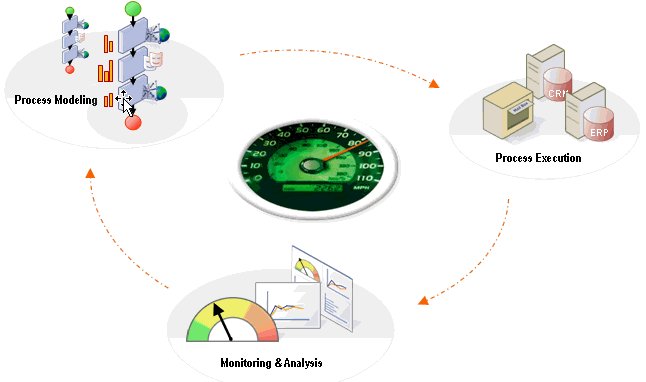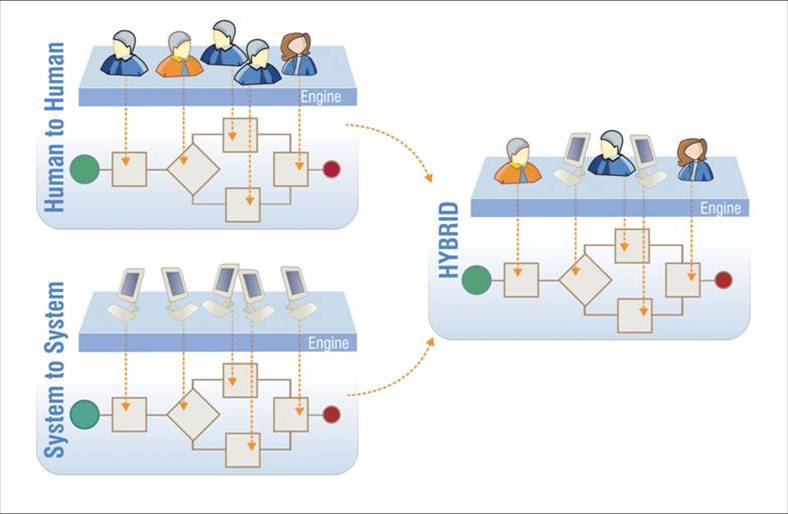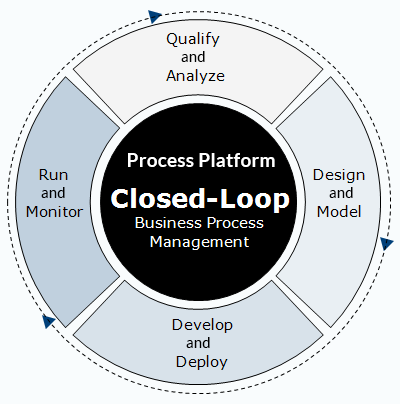Business Process Management Suite |
|
Business Process Management (BPM) refers to the activities related to designing, executing , and monitoring of processes in an organization. These activities are important for both process automation and process improvement, and are implemented through a set of tools and applications which form the Business Process Management Suite (BPMS). In a BPMS, designing and storing are design-time activities, whereas execution and monitoring are run time activities.

Design-time activities include modeling of business processes. A BPMS enables you to define and outline business practices, processes, information flows, data stores, and systems in an organization through business modeling. It provides graphical tools to design business models and repositories to store them.
At run time, the BPMS translates the designed models into a computer language, which can be directly executed. It uses external applications, such as Web services, to operate the processes. At run time, it also helps in tracking the business processes for improvement and optimization, using business monitoring software.
Key Features
The Process Platform Business Process Management Suite (BPMS), enables you to model, visualize, execute, monitor, and optimize business processes. It helps you model and develop your business processes with seamless integration between systems, applications, personnel, customers, and regulatory agencies.
Process Platform BPMS provides a rich, graphical modeling environment to model business processes, organization models and case models. It allows you to attach roles to activities in a process, and design compensates, time-outs, and exceptions in a business process model. The event-driven execution layer handles human-to-human and system-to-system interaction through a process engine, which executes business process models designed in the Process Platform business process modeling environment. To be able to execute a process model, the graphical Business Process Modeling Notation (BPMN) is converted into its corresponding Business Process Modeling Language (BPML).
Business Process Modeling Language (BPML) is a meta-language for modeling business processes and is an industry standard. Business processes that are modeled using BPML can be graphically represented using Business Process Modeling Notation (BPMN), an associated standard. BPML includes specifications for transactions, data flow, messages, scheduled events, business rules, security roles, exception handling and transaction compensation.
Execution of process models using a BPMS requires a flexible and comprehensive infrastructure, which usually makes it impossible or difficult to implement such systems in a legacy IT environment. However, the Process Platform's BPMS takes the help of Process Platform ESB and the underlying service oriented architecture (SOA) to overcome this limitation.
Process Platform's BPMS has the following key features:
- Business process modeling through an intuitive graphical modeling environment
- Modeling of system-to-system and human-to-system interaction

- Multi-layer modeling of business processes
- Transactional business process management to support short-lived, high-speed, and high volume transactions
- Graphical business flow and integrated rule engine with decision tables
- Web services integration
- Test simulation of processes through a robust debugger
- Process execution and real-time monitoring capabilities
- Process redesign and optimization capabilities
- Enables data recovery during system failures
- Supports carrying message traffic reliably
- Uses Business Process Modeling Language and Business Process Modeling Notation as underlying standards.
Business Process Cycle
The business objectives of an enterprise determine the way its business processes are modeled. Using Process Platform, you can analyze the existing processes and identify scope for improvement, and design/model processes based on your business goals and objectives. You can develop and deploy the processes, and subsequently monitor what you have deployed. Process Platform enables you to not only design and automate routine tasks, but also to orchestrate and optimize sophisticated processes involving people, information, applications and complex exception-handling scenarios. At the core of the Process Platform solution is a continuous process management cycle that follows the natural flow of an enterprise, involving analysis, design, development, and monitoring.
The following table describes the activities at each stage.
Stage |
Description |
Benefit |
|---|---|---|
Qualify and Analyze |
|
Higher levels of suitability and adaptability of the designed processes to the organization, and continuous improvement through analysis and process rectification |
Design and Model |
|
Flexibility and agility in designing business processes that are governed by business requirements, independent of any IT platform |
Develop and Deploy |
|
Scalable and stable deployment ensuring excellent business continuity, high availability, and easy expansion of IT infrastructure |
Run and Monitor |
|
Constant monitoring that promises improved transparency, efficiency, effectiveness, and increased support for decision-making |
Embedding this closed-loop of BPM in itself, Process Platform provides you with the following advantages:
- Scope for continuously redefining and improving processes, taking business performance to the next level of efficiency
- Greater control over businesses through a streamlined governance mechanism based on real-time data, thereby providing a stronger competitive edge
- User-friendly modeling environment enabling easier and swifter process changes and adaptability